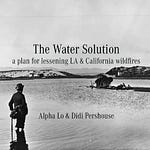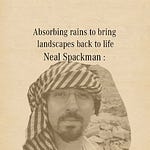In this podcast episode I discuss a plan to rehydrate California in order to help lessen the wildfires that have been hitting the state in the past few years. Elements of the strategy are also applicable to elsewhere around the world.
Share in the comments section your thoughts on this plan, and other ideas for rehydrating California
Strategy:
Bring back the fog. California has lost a third of its fog over the last few decades [ref 1,2]. Vegetation uses the fog to keep hydrated. [ref 3-5] This can be done by lessening the urban heat dome effect in coastal California cities. Regreening our towns will decrease the heat emitted from them, which lessens fog. [ref 6]
Bring back wetlands in Central, Eastern and Southern California. Wetlands were once prevalent in Central California [ref 7] .Wetlands help create more humid air. As the winds, the Santa Anas and the Diablos, blow past these areas, they become less dry and hot. When the winds hit the mountains, they are less likely to fan wildfires. One way to bring back wetlands to the Central Valley is to have aquaponic wetland farms there. [ref 8] One way to bring back wetlands in Eastern california is to stop piping water from there to Southern California. Rivers will naturally create more wetlands if not dammed. Re-introducing beavers also helps rivers flow into floodplains and create wetlands.
Stop damming and piping so much of the water to Southern California cities and Central California farms. This leaves more water to hydrate the wilderness, lessening fires there. Places like Owens valley which got desertified for LA’s sake, can get regreened. Owen’s lake can come back naturally. Also undoing the dams will allow the sediment to create soil to grow more vegetation. Allowing rivers to overflow into floodplains hydrates the floodplains, and helps grow more vegetation there. Allowing rivers to run and overflow again will naturally lead to more wetlands in Central California again.
Stop using tile drainage systems in Central California farms which pipe out water from the soil to the ocean, so that the water is not used as efficiently in the landscape. Increasing the soil organic matter in farms will allow them to absorb more water and create less runoff. They then need a lot less water, and do not need to take so much water from dams. Currently 40% of Californias water is used for farms. This percentage can be much less while keeping the input the same.
Replenish aquifers in Central California by allowing rivers to overflow onto farmland during wet season. [ref 9] This creates a temporary wetlands on the farms, and allows the water to drain into aquifers below. As aquifers refill, farms can use more water from below rather than have it piped from dams elsewhere.
Guide rainfall back into the landscape in urban areas, farm areas, and in the wilderness. Swales, terraces, berms, wetlands, raingardens are various ways to do this. Guide our storm drainage to refill aquifers and rehydrate the environment rather than runoff to ocean. As more rainfall is in landscape there will also be more evapotranspiration, which can then add to the humidity in the air to create more rainfall downwind and inland.
Use the aquifers below Los Angeles and San Diego to store rainwater. And guide the stormwater into wetlands which clean the water, and then pass it to aquifers below. Billion dollar stormwater wetland projects are currently underway in LA. This will allow southern california to pipe less of its water from dams elsewhere. Those dams will then not dry up so much of the wilderness.
Rewild California. As more soil builds and vegetation grows, the rainwater gets slowed down. It seeps underground, and then can come out months later to keep rivers flowing year round into dry and fire season. This year round flow keeps the landscape hydrated. Also the vegetation evapotranspires water to create more rainfall. There is an effect called moisture hopping where water vapor is transpired into the air to create rainfall downwind. Water from the ocean is brought inland that way [ref 10,11] Ocean water is brought inland on a conveyor belt which is activated by a continual chain of vegetation growing from shore to inland. This then creates rain inland which can help lessen wildfires. The small water cycle, which is where water moves from land to sky and back to land again, can be restored to its full capacity. [ref 12,13]
You can subscribe to this newsletter for free or from $5 a month. Money goes to supporting the regenerative water movement.
References
"Clearing and present danger: Fog that nourishes California redwoods is declining" Tennesen Sci.American(2010) https://www.scientificamerican.com/article/fog-that-nourishes-california-redwoods-declining/
"Climate context and ecological implications of summer fog decline in coast redwood region" Johnstone, Dawson PNAS March 9, 2010 107 (10) 4533-4538; https://doi.org/10.1073/pnas.0915062107
Berry ZC, Emery NC, Gotsch SG, Goldsmith GR. Foliar water uptake: Processes, pathways, and integration into plant water budgets. Plant Cell Environ. 2019 Feb;42(2):410-423. doi:10.1111/pce.13439
Redwood leaves get 2-11% of their hydration through foliar uptake i.e. water coming through leaves
Limm EB, Simonin KA, Bothman AG, Dawson TE. Foliar water uptake: a common water acquisition strategy for plants of the redwood forest. Oecologia. 2009 Sep;161(3):449-59. doi: 10.1007/s00442-009-1400-3
Qiao, N., Zhang, L., Huang, C., Jiao, W., Maggs-Kölling, G., Marais, E., & Wang, L. (2020). Satellite observed positive impacts of fog on vegetation. Geophysical Research Letters, 47, e2020GL088428. https://doi.org/10.1029/2020GL088428
Gautam, R., & Singh, M. K. (2018). Urban heat island over Delhi punches holes in widespread fog in the Indo-Gangetic Plains.Geophysical Research Letters,45,1114–1121. https://doi.org/10.1002/2017GL076794
https://storymaps.arcgis.com/stories/dcfa9c9fa6464e89a45924a4ebec5a15?utm_source=social&utm_medium=social&utm_campaign=mapmonday-CaliforniaWetlands-051721
https://www.ted.com/talks/dan_barber_how_i_fell_in_love_with_a_fish
https://www.kcra.com/article/new-research-explores-how-farmers-can-help-california-rebuild-groundwater-supply/39840234#
Van der Ent, R. J., Savenije, H. H. G., Schaefli, B., and Steele-Dunne, S. C. (2010), Origin and fate of atmospheric moisture over continents, Water Resour. Res., 46, W09525, doi:10.1029/2010WR009127
Dominguez, F., Villegas, J. C., and Breshears, D. D. (2009), Spatial extent of the North American Monsoon: Increased cross-regional linkages via atmospheric pathways, Geophys. Res. Lett., 36, L07401, doi:10.1029/2008GL037012
"New water paradigm: Water for the recovery of the climate" M. Kravčík, J. Pokorný, J. Kohutiar, M. Kováč, E. Tóth http://www.waterparadigm.org/download/Water_for_the_Recovery_of_the_Climate_A_New_Water_Paradigm.pdf
Millán, Millán M. "Extreme hydrometeorological events and climate change predictions in Europe." Journal of Hydrology 518 (2014): 206-224














Share this post